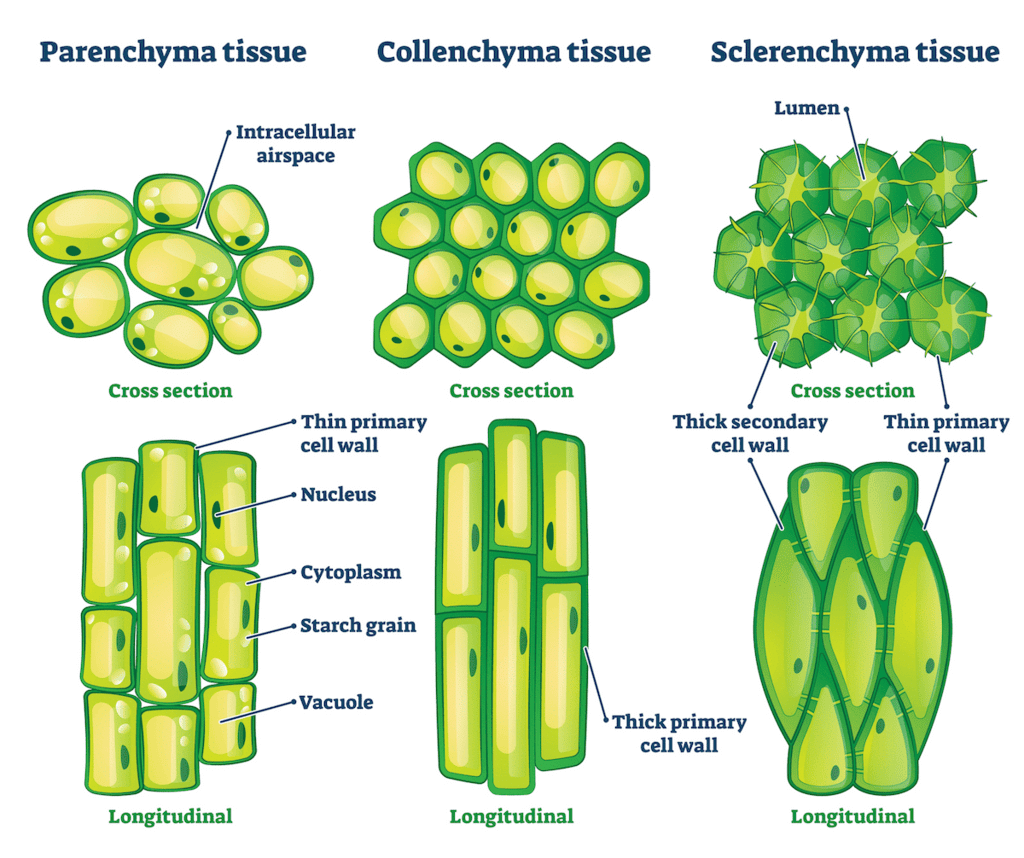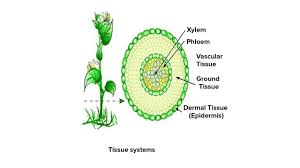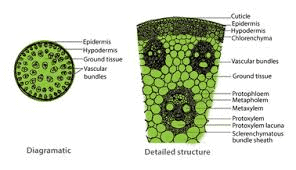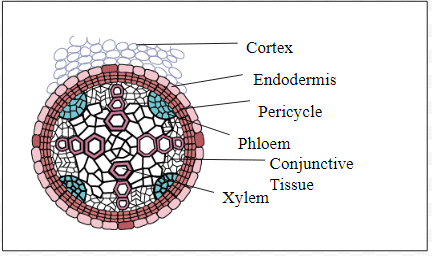|
Tissues in plants differ based on the types of cells they contain and their specific locations within the plant body, which affects their structure and functions. This categorization allows for the specialization of tissues to perform distinct roles within the plant.
|
Card: 2 / 82 |
|
The three main types of tissue systems in plants are the epidermal tissue system, the ground or fundamental tissue system, and the vascular or conducting tissue system. Each system serves different functions and has distinct structural characteristics.
|
Card: 4 / 82 |
|
Anatomical differences between monocots and dicots are significant because they reflect the different evolutionary adaptations and functions of these two groups of angiosperms, influencing aspects such as growth patterns, nutrient transport, and overall plant structure.
|
Card: 6 / 82 |
|
Epidermal hairs, including root hairs and stem hairs (trichomes), are extensions of epidermal cells. Root hairs are unicellular and assist in water and mineral absorption, while stem hairs can be multicellular and serve functions such as preventing water loss through transpiration.
|
Card: 8 / 82 |
|
The ground tissue system in flowering plants consists of simple tissues such as parenchyma, collenchyma, and sclerenchyma, which are found in various parts including the cortex, pericycle, pith, and medullary rays.
|
Card: 10 / 82 |
|
Mesophyll is the ground tissue in leaves, composed of thin-walled chloroplast-containing cells that are essential for photosynthesis, allowing the plant to convert light energy into chemical energy. |
Card: 12 / 82 |
|
The vascular tissue system consists of complex tissues, namely phloem and xylem, which form vascular bundles responsible for conducting water, minerals, and food throughout the plant. |
Card: 14 / 82 |
|
Open vascular bundles, found in dicotyledonous stems, have cambium present between phloem and xylem, allowing for secondary growth, while closed vascular bundles, typical of monocots, lack cambium between these tissues. |
Card: 16 / 82 |
|
Explain the arrangement of xylem and phloem in radial and conjoint vascular bundles. |
Card: 17 / 82 |
|
In radial vascular bundles, xylem and phloem are arranged alternately on different radii, as seen in roots. In contrast, in conjoint vascular bundles, both xylem and phloem are located at the same radius, with phloem typically on the outer side of the xylem, as observed in leaves and stems. |
Card: 18 / 82 |
|
The epiblema serves as the outermost layer of the root and is involved in water and mineral absorption through root hairs that protrude from its surface. |
Card: 20 / 82 |
|
The cortex consists of several layers of thin-walled parenchyma cells with intercellular spaces, responsible for the storage and transportation of food materials. |
Card: 22 / 82 |
|
The pericycle, located next to the endodermis, consists of thick-walled parenchyma cells and is crucial for initiating the formation of lateral roots and vascular cambium during secondary growth. |
Card: 24 / 82 |
|
The pith, typically small or inconspicuous, contains parenchymatous cells that store food materials and provide mechanical support to the root. |
Card: 26 / 82 |
|
Conjunctive tissue consists of parenchymatous cells situated between the xylem and phloem, playing a role in the support and transport of materials within the root. |
Card: 28 / 82 |
|
Xylem conducts water and minerals upwards from the roots, while phloem transports food materials both upwards and downwards, facilitating nutrient distribution throughout the plant. |
Card: 30 / 82 |
|
Cambium develops between the xylem and phloem and is responsible for secondary growth, allowing the plant to increase in girth over time. |
Card: 32 / 82 |
|
The stele consists of all the tissues located on the inner side of the endodermis, including the pericycle, vascular bundles, and pith, and is responsible for the transport of water, minerals, and food materials throughout the root. |
Card: 34 / 82 |
|
What are the key differences between monocotyledonous and dicotyledonous roots? |
Card: 37 / 82 |
|
Monocotyledonous roots typically have more than six xylem bundles (polyarch) compared to the 2-4 xylem bundles found in dicotyledonous roots. Additionally, monocot roots have a large and well-developed pith and do not undergo secondary growth. |
Card: 38 / 82 |
|
A monocotyledonous stem features a sclerenchymatous hypodermis, numerous scattered vascular bundles each surrounded by a sclerenchymatous bundle sheath, and a prominent parenchymatous ground tissue. The vascular bundles are conjoint and closed, with peripheral bundles being smaller than the centrally located ones. Notably, phloem parenchyma is absent, and there are water-containing cavities within the vascular bundles. |
Card: 40 / 82 |
|
What distinguishes the vascular bundles in a monocotyledonous stem from those in a dicotyledonous leaf? |
Card: 41 / 82 |
|
In a monocotyledonous stem, vascular bundles are scattered throughout the ground tissue and are conjoint and closed, meaning they do not have cambium and are not arranged in a ring. In contrast, dicotyledonous leaves have vascular bundles that are typically organized in a reticulated pattern within the mesophyll, surrounded by bundle sheath cells, and are generally larger at the midrib and veins. |
Card: 42 / 82 |
|
Explain the role and structure of mesophyll in a dorsiventral dicotyledonous leaf. |
Card: 43 / 82 |
|
Mesophyll in a dorsiventral dicotyledonous leaf functions primarily in photosynthesis and gas exchange. It is located between the upper and lower epidermis and consists of parenchyma cells containing chloroplasts. The mesophyll is differentiated into two types: palisade tissue, which is elongated and positioned close to the adaxial surface for maximum light absorption, and spongy parenchyma, which has rounded cells with large air cavities and intercellular spaces facilitating gas exchange. |
Card: 44 / 82 |
|
Isobilateral leaves in monocotyledons have stomata present on both sides, mesophyll cells that are not differentiated into palisade and spongy parenchyma, and bulliform cells that regulate leaf surface exposure and curling. The vascular bundles are similar in size due to parallel venation, with the midrib vascular bundles being larger. |
Card: 46 / 82 |
|
Bulliform cells are modified epidermal cells found on the veins of monocot leaves. They are larger than typical epidermal cells and play a crucial role in regulating the leaf's surface exposure. When turgid, they cause the leaf to spread out, while flaccid bulliform cells lead to leaf curling to reduce water loss. |
Card: 48 / 82 |
|
Meristematic tissue is divided into three types: 1) Apical meristem, located at the tips of roots and shoots, which produces primary tissues; 2) Intercalary meristem, found between mature tissues, especially in grasses, facilitating growth; 3) Lateral meristem, located on the sides of the plant, which contributes to the increase in girth and includes secondary meristems like vascular and cork cambium. |
Card: 50 / 82 |
|
Permanent tissue in plants is defined as cells that have become structurally and functionally specialized, losing the ability to divide. These tissues are characterized by their lack of division capacity. |
Card: 52 / 82 |
|
Parenchyma is a simple permanent living tissue composed of thin-walled isodiametric cells that contain a large central vacuole and peripheral cytoplasm with a nucleus. It is found in the non-woody and soft areas of stems, roots, leaves, fruits, and flowers, serving to store food and provide turgidity to the softer parts of the plant. |
Card: 54 / 82 |
|
Collenchyma is distinguished by its cells that are thickened at the corners due to cellulose, hemicellulose, and pectin. These cells can be oval, spherical, or polygonal and often contain chlorophyll, providing mechanical support to the growing parts of plants, such as young stems. |
Card: 56 / 82 |
|
Sclerenchyma consists of long, narrow cells with thick, lignified cell walls and may have few or numerous pits. This tissue is typically dead and lacks protoplasts. Sclerenchyma can be classified into two types: fibres, which are thick-walled and elongated, and sclereids, which are thickened dead cells with narrow cavities. Sclerenchyma provides mechanical support to various plant organs. |
Card: 58 / 82 |
|
Complex tissue in plants is characterized by being composed of multiple types of cells that work together as a unit. Unlike simple tissues, which consist of similar cells, complex tissues have diverse cell types that perform various functions collectively. |
Card: 60 / 82 |
|
The main functions of xylem in flowering plants are to conduct water and minerals upward from the roots to the leaves and to provide mechanical support due to its lignified walls. |
Card: 62 / 82 |
|
What distinguishes the xylem structure in gymnosperms from that in angiosperms? |
Card: 63 / 82 |
|
Gymnosperms lack vessels in their xylem, which are present in angiosperms. Instead, gymnosperms primarily consist of tracheids for water conduction. |
Card: 64 / 82 |
|
Phloem is responsible for transporting food materials, primarily from the leaves to other parts of the plant. It comprises sieve tube elements, companion cells, phloem parenchyma, and phloem fibers. Sieve tube elements are long structures that facilitate transport, while companion cells support their function by maintaining pressure gradients. |
Card: 66 / 82 |
|
Companion cells help regulate the function of sieve tube elements by controlling the pressure gradient necessary for the transportation of nutrients. They possess a nucleus, which is essential for the metabolic functions of the sieve tubes. |
Card: 68 / 82 |
|
Protoxylem is the early-formed xylem that appears first during development, while metaxylem is the later-formed xylem. In stems, protoxylem is located towards the center in an endarch arrangement, whereas in roots, it is found towards the periphery in an exarch arrangement. |
Card: 70 / 82 |
|
How does the composition of phloem in gymnosperms differ from that in angiosperms? |
Card: 71 / 82 |
|
In gymnosperms, phloem consists of sieve cells and albuminous cells, lacking sieve tubes and companion cells, which are characteristic of angiosperms. This structural difference affects their transport efficiency. |
Card: 72 / 82 |
|
Phloem fibers, also known as bast fibers, are made up of sclerenchymatous cells and are generally found in the secondary phloem. They are not present in the primary phloem and are commercially important in plants like jute, flax, and hemp. |
Card: 74 / 82 |
|
The cambial ring is more active in spring, resulting in the formation of a larger number of xylem elements with wider vessels. In contrast, during winter, the cambium is less active, producing fewer xylem elements with narrower vessels. |
Card: 76 / 82 |
|
What happens to the primary and secondary phloems as secondary xylem accumulates? |
Card: 77 / 82 |
|
As secondary xylem continues to accumulate due to the active growth of the cambium, the primary and secondary phloems gradually get crushed under the pressure of the expanding xylem. |
Card: 78 / 82 |
|
Secondary medullary rays are narrow bands of parenchyma formed by the cambium that pass radially through both secondary xylem and secondary phloem. They play a role in the storage and transport of nutrients within the wood. |
Card: 80 / 82 |
|
Cork cambium, or phellogen, is a lateral meristem that originates in the cortical zone and is composed of a couple of layers of thin-walled, rectangular cells. It produces cork (phellem) on the outside and secondary cortex (phelloderm) on the inside, providing protection and acting as an epidermis due to its impervious nature. |
Card: 82 / 82 |















































